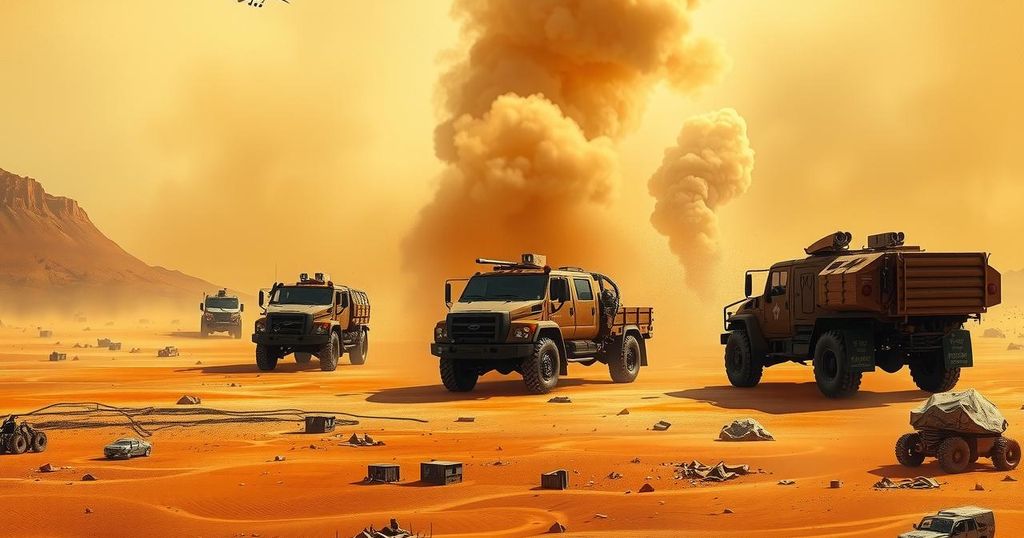Global news
AFRICA, AFRICA CORPS, ASIA, ASSOCIATED PRESS, AZAWAD, BAMAKO, CHINA, CIVIL WAR, EUROPE/ASIA, KIDAL, KREMLIN - CONTROLLED AFRICAN CORPS, LYAMMOURI, MALI, MILITARY, MOHAMED MAOULOUD RAMADAN, MOROCCO - BASED POLICY CENTER FOR THE NEW SOUTH THINK TANK, NEW SOUTH THINK TANK, RID, RIDA LYAMMOURI, RUSSIA, TERRORISM, WAR
Leila Ramsay
0 Comments
Clashes in Northern Mali Result in Multiple Deaths Amid Ongoing Conflict
Clashes in northern Mali between the army and separatists resulted in 10 separatist deaths and claims of numerous Malian military fatalities. The conflict highlights the ongoing instability in the Kidal region, complicated by foreign mercenary involvement. Amid difficulties in gathering intelligence, the withdrawal of Russian forces further muddles Mali’s security situation.
In a distressing turn of events in northern Mali, clashes erupted between Malian security forces and an armed separatist group, resulting in the death of 10 separatists over the course of two days. The Malian army confirmed the fatalities on Friday, while the Azawad separatists claimed they had killed numerous Malian soldiers alongside members of a Russian-controlled force. This conflict highlights the ongoing tensions in the region, which has seen consistent violence and instability.
The clashes began during a military offensive in the Kidal region on Thursday, as reported by the Malian military. An ambush on a logistics convoy followed on Friday, which the army managed to repel. The separatists have said that many of their attackers fell victim to this ambush, allegedly claiming the lives of dozens of Malian soldiers and fighters from the Kremlin-controlled African Corps. This statement adds to the chaotic nature of the ongoing situation.
The Azawad separatist movement, which has been engaged in a long-standing battle for an independent state in northern Mali, briefly expelled Malian security forces from the region prior to a 2015 peace agreement that fell apart. In a statement, Mohamed Maouloud Ramadan, a spokesman for the Azawad, confirmed the recovery of supplies from the ambushed convoy, as well as the loss of three of their own members. He mentioned seizing 12 trucks loaded with cereals and diesel, alongside military vehicles.
Videos circulating online, purportedly from the separatists, depicted the aftermath of the attack, showcasing burning military trucks in a desert landscape. However, the authenticity of these videos has not been independently verified by the Associated Press. They also included distressing imagery of bodies dressed in what appeared to be Malian army uniforms, underscoring the severity of the conflict.
Rida Lyammouri, a Sahel expert affiliated with a Moroccan think tank, commented on the inherent challenges facing security forces in Mali, particularly in the remote regions like Kidal. He noted that this geographic disadvantage significantly hampers intelligence gathering, thus favoring armed groups and jihadist factions in their operations.
The skirmishes come shortly after the announcement from Russia’s mercenary group Wagner, which has assisted Malian forces against armed groups for over three years, regarding its withdrawal from the country. Meanwhile, the African Corps, which answers to the Russian defense ministry, remains operational within Mali. Current estimates suggest that around 2,000 mercenaries are stationed in the region, although it’s uncertain how this number divides between Wagner and the Africa Corps.
This pattern of violence continues to reveal Mali’s struggles against the backdrop of proscribed separatism and foreign influence, pointing to an ongoing saga of conflict fueling instability in the region.
The clashes in northern Mali reveal the persistent nature of armed conflict involving separatist groups and the Malian army, compounded by the presence of foreign mercenaries. The situation is exacerbated by difficult terrain and intelligence challenges, presenting formidable barriers to stability in the region. This episode underscores not only the local struggle for power but also the broader implications of international military involvement in domestic conflicts, particularly with the withdrawal of Russian forces complicating the landscape further.
Original Source: www.newsday.com




Post Comment